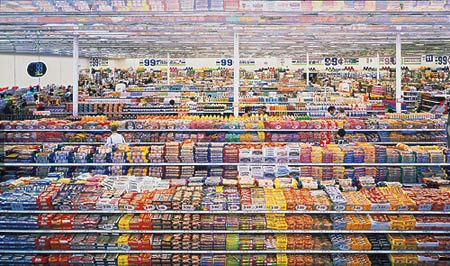Personal Favourite: 99 Cents by Andreas Gursky

Andreas Gursky’s “99 Cents” is not just one of my personal favourites, it probably is the one, the photo that I would name - when pressed - as my personal favourite photo. For me, “99 Cents” embodies all that makes contemporary photography the exciting art form that it has become.
Needless to say, the first thing to realize about the photo is its size. The reproduction above is about 660 times smaller than the actual print. While reproducing images online always diminishes the original art work, for Gursky’s “99 Cent” the impact is pretty much as bad as it can get.
Much has been made about the sizes of Gursky’s photographs (with criticism of his print sizes now being one of the mantras on photography internet boards, along with, for example, the usual “discussions” of Photoshop, or complaints about Gregory Crewdson’s large budgets and crews). The point, of course, is that bigger is not always better, but in the case of “99 Cents” it actually is. “99 Cents” is not a good photo because it is big, but (in part) because the size is used for maximum impact. “99 Cents” just has to be the size it is for it to work, and there is no other way to find out why than to stand in front of it.
Despite its fairly rigid structure and composition, “99 Cents” is a visual assault, with its almost endless amount of detail. As with size, arguing about the amount of detail is chasing after another red herring.
One could argue that “99 Cents” is quite unremarkable, because it shows something that we see every day. But then, while it does show something that we could see every day, in reality it shows us something that we don’t see every day. Because when confronted with the kind of place that “99 Cents” shows us, we usually go into survival mode and try to just look for what we need to leave as quickly as possible. As humans, we are not built to react to that many visual stimuli, and since advertizers and creators of products know we will shut off, they up the ante and create even more visual stimuli.
So “99 Cents” is not just a photo of one of the stores that we spend so much time in, it also tries to show us what we’re up against. This is the world that we have created (and a large part of which we are now forced to ignore), and Gursky’s work makes you look at it. No more, no less. That is why, for me, “99 Cents” is such a great photo.